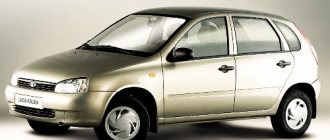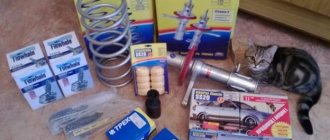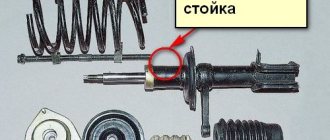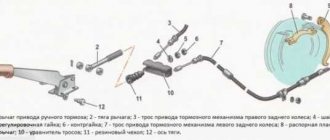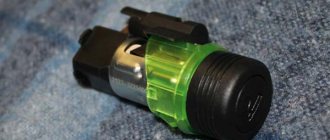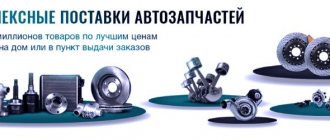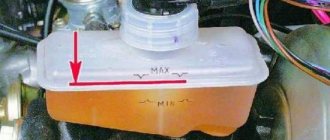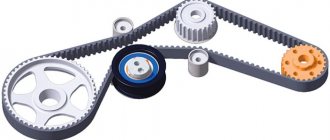After installing the new front suspension from SS20, of course, I was happy with everything, both the smooth operation of the shock absorbers and the disappearance of knocks on the rebound. But after some time, a strange sound began to appear more and more clearly, especially when turning the steering wheel all the way. I began to blame the support bearings, and even decided to remove the struts and look at their condition. But after dismantling it turned out that everything was fine with them.
As for the sound, my assumptions are as follows. Since the springs were slightly lower, and the SS20 strut rod itself was slightly longer than on the factory struts, it turns out that the spring was almost always in an unloaded state. I even dismantled the springs today without ties, since they were useless. In the end, I decided that these strange squeaks (knocks) were coming from the spring, since it was not really tightened with such a design as the SS20.
In general, I decided to put back the factory springs, leaving the struts, supports and bearings in place. Everything became normal, but when I lowered the car to the ground, I simply couldn’t believe my eyes: the front end was now even higher than on the factory suspension. I think many people have guessed why this picture turned out:
The fact is that the SS20 strut rod is about 3 cm longer than the SAAZ one, and maybe even more, I just didn’t specifically measure the difference today. It turns out that with the original spring, the front end rises about 3 cm. That is, it turns out to be a kind of Kalina Cross variant.
Why lower the Lada Priora?
On the roads of our country you can often find “Priors” with a low landing. The main reason why owners resort to this solution is to improve the appearance of the car. Lowering allows you to give the car a sporty look. In this budget way, the VAZ 2170 can be distinguished from the road traffic. When lowering work is carried out correctly, the following benefits can be obtained:
- reduce roll when cornering;
- improve the handling and behavior of the car at high speeds.
One of the main disadvantages of lowering a car lies in the quality of the roads: any hole or unevenness can lead to serious damage to body elements or vehicle components (bumpers, sills, engine crankcase, exhaust system). Due to the low seating position, the owner has to visit a car service much more often to fix certain problems. Therefore, if you want to make your “Priora” below, you need to take into account the following disadvantages of such a procedure:
- you will have to plan your route more carefully;
- incorrect lowering can lead to rapid failure of suspension elements, in particular shock absorbers;
- Due to increased suspension rigidity, the level of comfort decreases.
Difficulties after replacement
Before the owner decides to intervene in the design of his car such as lowering the suspension, he must clearly understand that he will not be able to drive his car in the same manner. If you, at least occasionally, travel outside the city, where the road surface leaves much to be desired, not to mention country roads, then you should forget about lowering the suspension.
Such cars are designed for driving within the city, on smooth asphalt. Otherwise, the car’s suspension will not withstand frequent rebounds and will fall apart. Just like body elements such as bumpers and sills will be at least scratched.
The biggest disadvantage that needs to be eliminated
Now I want to talk about one significant disadvantage that you will have to face when installing original springs paired with SS20 struts and supports from the same company. As mentioned above, the rod is slightly longer than on the factory SAAZ. It turns out that when the car wheel is fully suspended and the steering wheel is turned all the way, the tie rod tightening bolts will cling to the end of the hole in the body. This is what it looks like in practice:
You can take my word for it that one such time, when the steering wheel is fully turned in one direction or the other, the metal at the point of contact is crushed and the following damage occurs:
In fact, I don’t see anything critical in this, since when turning again everything goes almost smoothly. If you want to get rid of constant clinging, you can use pliers to bend the required section of metal in the hole from below (at the point of contact). Of course, I’m not sure that I’m strong enough to do this with pliers, but I can try. Or use a round file to do it more civilly. But after that you will definitely need to carefully treat this place with an anticorrosive agent, and the more, the better. I haven’t done this yet, but on my first trip to the village I’ll do it, since the bottle of mastic was left there.
Another point that may arise, but I personally have not noticed this. Since the rack has become longer when fully suspended, the brake hose is tightened more, but not critically. In my case, the tension is quite acceptable, which is unlikely to lead to a break.
In general, of course, that moment with metal damage is not very pleasant, but I don’t really bother about it, I’ll do everything in the near future, file a couple of millimeters or bend it even further so that nothing sticks anymore, and then thoroughly fill this place with anti-corrosion treatment . I wanted to describe my new spring ties in this article, but I’m already thinking that it’s better to make a separate post about this.
How to lower the Priora correctly
There are several ways to lower the landing position on the Priora. Each of them is worth dwelling on in more detail.
Air suspension
Air suspension is considered one of the best, but at the same time expensive, ways to lower a car. The driver can raise or lower the car body as necessary. In addition to the high cost of such equipment, the work must be carried out by specialists who understand the electronics and chassis of the car. Therefore, most Prior owners prefer less expensive methods of undervaluation.
Suspension with adjustable ground clearance
The Priora can be equipped with a special adjustable suspension kit. Height adjustment is carried out by means of struts, and springs with a selected lowering (-50, -70, -90) are compressed or stretched. Thus, the car can be raised for the winter and lowered for the summer. The springs that come with the kit are highly reliable and are designed to constantly change in length. The set in question consists of the following elements:
- front and rear springs;
- screw-adjustable struts and shock absorbers;
- front upper supports;
- spring cups;
- bumpers.
The procedure for implementing such a kit comes down to replacing the standard suspension elements with new ones:
- Remove the rear shock absorbers along with the springs.
It is recommended to lubricate the threaded part of the shock absorbers with graphite lubricant.
Lowered suspension
This method of lowering the suspension is less expensive than the previous one. It involves purchasing a set of shock absorbers and lowered springs (-30, -50, -70 and more.). The disadvantage of this kit is the impossibility of adjusting the ground clearance. However, you can install such a suspension yourself. To replace you will need the following kit:
- Demfi -50 racks;
- springs Techno Ressor -50;
- supports Sevi Expert.
avtoexperts.ru
In our country, where high ground clearance is considered one of the main characteristics when choosing a car, there are people who, on the contrary, strive to lower the ground clearance. There are relatively few of these enthusiasts, but they exist and they use different methods of changing the ground clearance - both budget and expensive. In this article we will look at various options for lowering the suspension and talk about the advantages and disadvantages of each of them.
Lowered BMW 5-Series E60
Budget options
Those who really want to make a real sports car out of their car go to reasonable and not so reasonable expenses. But not everyone has the budget to replace many suspension components in order to achieve a reduction in ground clearance. Therefore, the cheapest ways to lower the vehicle's ground clearance are used.
Method number 1 . Trimming standard car springs. You can entrust this operation to any car mechanic, or you can do it yourself. If you decide to shorten the springs yourself, then you should arm yourself with several tools: a jack, a pair of pry bars and a device for cutting down the springs (a metal saw or an angle grinder - “grinder”).
cutting springs
There are two options here - with removing the springs and with cutting the springs without dismantling them. Both options are quite labor-intensive, so you can’t do it without helpers. The procedure for shortening the springs itself is quite simple: the front springs, as a rule, have two upper turns cut off, and the rear ones three. This is done to balance the car, because the load in front is greater due to the engine.
Cut spring
The trimmed springs are put back in place (if the first trimming option was chosen), then alignment/camber is done. The advantages of this option are its low cost. The disadvantages are that by cutting off the standard springs, you remove the so-called support coil, which can significantly worsen the interaction of the spring with the support cup. This is fraught with a tightening of the suspension, which can ultimately lead to failure of both the spring itself and other elements of the chassis (for example, shock absorbers).
Method number 2 . Installation of lowering springs. Such springs are also called sports springs, since they are recommended to be installed in conjunction with sports struts. However, manufacturers of such springs make special products compatible with standard shock absorbers. Lowering springs are shorter than standard ones (by 40 mm on average).
Eibach lowering springs
The installation of such springs can be done either independently or at a service station. It is best to use the services of service stations, since there you can immediately do a wheel alignment. The advantages of this option for lowering the suspension are that you do not damage the standard springs - if you want to return the car to its previous ground clearance, it will be enough to put the “original” springs in place. In addition, sports springs do not sag as much as original sawn-off springs - they have a certain stiffness set from the factory. The disadvantages are the monetary costs and rather harsh operation of the suspension if such springs are installed with “original” shock absorbers. Therefore, it is better to install sports springs with sports shock absorbers, preferably from the same manufacturer.
Method number 3 . Installation of coilovers. Another fairly inexpensive way to make a car's suspension lower is to install coilovers on the car - special sports springs that can be adjusted. Consequently, by installing these springs, the car owner can adjust the ground clearance as he pleases.
Coilovers
The peculiarity of these springs, in contrast to simple lowered ones, is their versatility. Coilovers can be installed both with standard shock absorbers and with special, shortened “sports” ones. In the first case, the driver saves on the cost of special struts, but in the second, he receives a full-fledged lowered suspension with screws, which can be adjusted to obtain a certain rigidity and ground clearance. Also, the second option is good because design changes to the suspension, if they affect the car’s handling, then, compared to installing coilovers with stock shock absorbers, only in a positive way.
Whichever of the above budget options for lowering the suspension you choose, remember - in any case, your car’s suspension will become stiffer and its travels shorter. And driving on Russian roads (unless it’s Moscow) will not be very comfortable.
Expensive option
Another option that only true sports car fans decide to shell out for is the installation of air suspension. The method is indeed very expensive, since you will have to buy such elements as front and rear airbags, pressure sensors (measure the pressure in the airbags), a control panel, a compressor and a receiver.
Air suspension
In addition to the high cost of these elements, installation is also expensive, which is best done at a specialized service station. The operation of installing an air suspension involves dismantling the standard springs and struts, and installing in their place air bags, special struts, air pressure sensors in the bags, a compressor, a receiver and a control panel. With its help, you can set various parameters of the suspension - adjust the ride height depending on the speed limit, the quality of the road surface and other factors.
Lada Niva on air suspension
The undeniable advantage, because of which, in fact, car owners choose this option, air suspension is that the car owner can get a wide range of ride height settings. The ground clearance of a car with such a suspension can be changed within 10-50 mm. In addition, installing air suspension has a positive effect on vehicle handling at high speed. And finally, another advantage of this type of suspension is that the car will not sag, even if you load it above normal.
Toyota Camry on air. Photo — Timur Amirov, Drive2.ru
The disadvantages of this option of lowering the standard suspension are no less significant. The first is the high cost of installation, repair and maintenance. And the second is its relatively small resource: in Russian conditions, air springs and pressure sensors can often fail due to driving on poor-quality roads.
Therefore, before giving preference to one of the above options for lowering the suspension, carefully consider the financial side of the issue. And remember that by deciding to undergo such an operation, you are making design changes to the suspension, which may affect the safety of the car.
Reviews from car enthusiasts about lowering the Priora suspension
Suspension 2110, supports VAZ 2110, front shock absorbers Plaza Sport shortened -50 gas oil, rear Bilstein b8 gazmas, springs all around Eibach -45 pro kit. To be honest, Eibachs lower the front well, but the rear is almost like stock. I put standard and Eibach springs next to each other, the difference is a centimeter and a half. I didn’t like the fact that the rear didn’t sit down at all and I put the phobos back: they really lowered them - 50, although they were on the 12 and sagged a little. Therefore, I would like the front to be a little lower.
hATE
https://www.lada-priora.ru/forum/showthread.php?p=226489
Understated. The racks around the SAAZ are ten-size, with shortened rods. In front there are TechnoRessor -90 springs, SS20 queen support springs (with a lowering of 1 cm), at the rear I cut off the original springs by 3 turns. The struts were pumped up for stiffness, because... the rod stroke is short. Bottom line, the car is a bouncer, it’s very rough, I feel every bump, a small wave - me and the sub in the trunk are bouncing.
byxoiLeXX
https://www.lada-priora.ru/forum/showthread.php?p=226489
On the original struts, put -30 in the rear, -70 in the front, it will lie flat. At first I set everything to -30, the rear was as it should be, the front was generally as it was, then I changed the front ones to -50 and still 2 cm higher than the rear.
Kova1enko
https://www.car72.ru/forum/viewtopic.php?t=73965&start=30
The Demfi struts themselves are a bit harsh. I have a KX -90, the springs are TechnoRessor -90 and two more coils have been sawn off at the back. I drive and rejoice, low and soft.
kos-jz
https://www.drive2.ru/communities/4035225266123971064/forum/288230376153233401
Lowering a car suspension is not an amateur activity. However, if you decide to carry out this procedure with your Priora, you need to familiarize yourself with the possible options, choosing the most suitable one. It is advisable to entrust changes to the suspension to an experienced mechanic or use special kits for lowering the landing, which you can easily install yourself.
